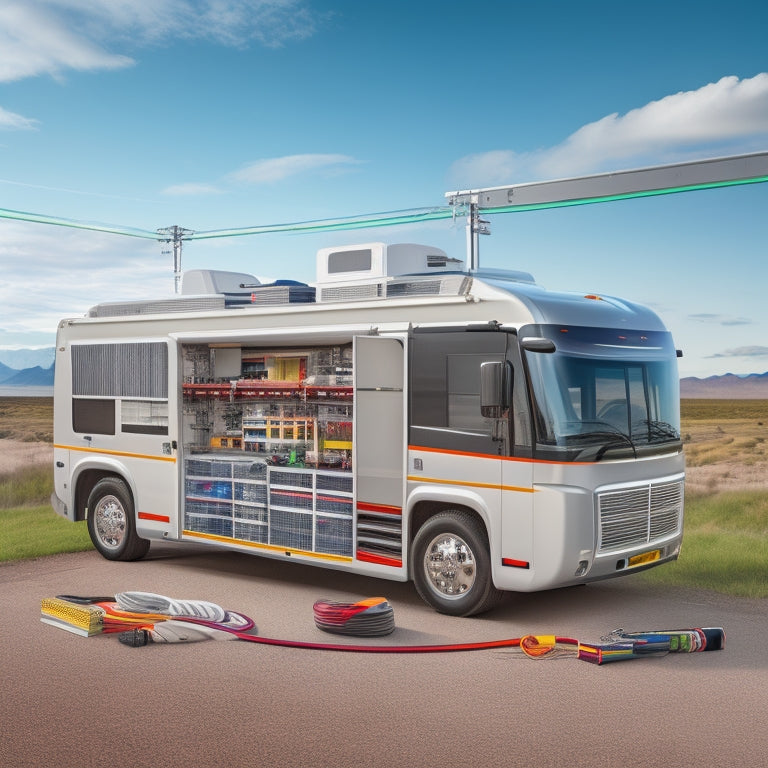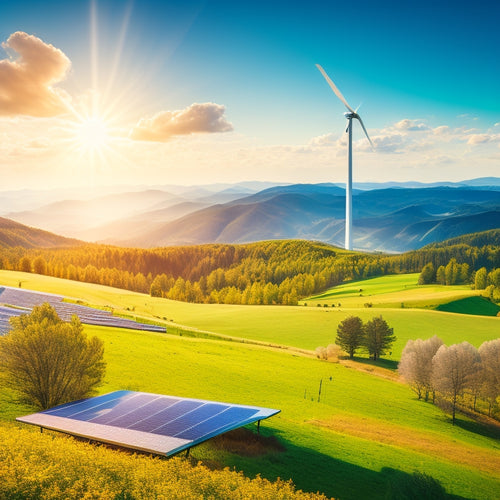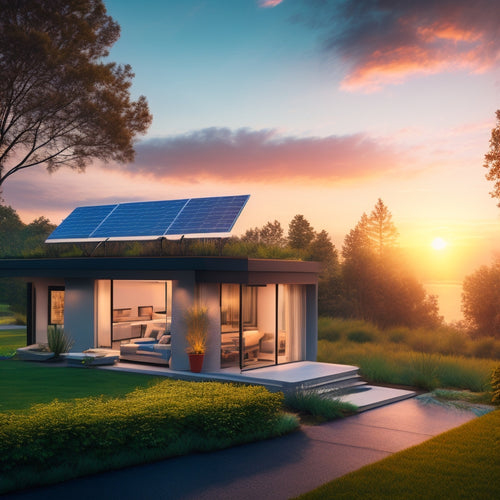
3 Best RV Power System Setup Tips
Share
When designing your RV power system, you'll want to start by evaluating your energy needs by calculating daily energy consumption and categorizing appliances into essential and non-essential. Next, choose the right components, such as solar panels, batteries, and inverters, considering factors like size, efficiency, and durability. Finally, optimize system performance by angling solar panels for maximum energy absorption, implementing regular cleaning schedules, and conducting routine battery maintenance. By following these tips, you'll be well on your way to a reliable and efficient RV power system, and exploring these concepts further will reveal even more opportunities to fine-tune your setup.
Overview
- Assess daily energy needs by calculating wattage ratings, categorizing appliances, and estimating usage hours to determine total watt-hours required.
- Choose the right components, including solar panels, batteries, inverters, and charge controllers, considering factors like efficiency, durability, and compatibility.
- Optimize system performance by angling solar panels at 30-40 degrees, implementing regular cleaning schedules, and conducting routine battery maintenance.
- Invest in high-efficiency inverters and power management systems to reduce energy losses and prevent overcharging and hazards.
- Monitor and adjust load management strategies to maximize power utilization and ensure optimal RV power system performance.
Assessing Your Energy Needs
When planning your RV power system, the first step is to determine how much energy you'll need to power your appliances and devices. You'll need to calculate your daily energy consumption to guarantee you have a sufficient power supply.
Start by making a list of all the devices you'll be using, including their wattage ratings. Understanding wattage is essential, as it will help you calculate your total energy needs.
Identifying daily energy usage is necessary to prioritize must-have appliances and allocate power effectively. Additionally, it's significant to categorize appliances into essential and non-essential to guarantee reliable power supply.
Next, estimate how many hours you'll use each device per day. Multiply the wattage by the hours used to get the total watt-hours (Wh) per day. Add up the Wh for all devices to get your total daily energy consumption.
This will give you a clear depiction of your energy needs, allowing you to design an RV power system that meets your requirements.
Choosing the Right Components
Now that you have a clear understanding of your daily energy needs, it's time to select the right components for your RV power system.
You'll need to choose solar panels that can generate enough power to meet your energy demands. Take into account the size, efficiency, and durability of the panels, as well as their compatibility with your roof's dimensions. For instance, look for panels with anodized aluminum frames and tempered glass, and compare brands based on efficiency, warranty, and durability ratings high-efficiency solar panels.
Next, decide on battery types, such as lead-acid, lithium-ion, or AGM, based on their capacity, lifespan, and maintenance requirements. It's crucial to take into account the depth of discharge (DOD) rating, as it affects the usable capacity before recharging.
Inverter options, like pure sine wave or modified sine wave, will impact your system's performance and compatibility with appliances.
Don't forget to select suitable charge controllers, wiring gauges, and power management systems to guarantee efficient energy flow and prevent overcharging or electrical hazards.
Optimizing System Performance
Optimizing your RV power system's performance requires careful consideration of several factors, from panel tilt and cleaning schedules to battery maintenance and load management.
You'll want to guarantee your solar panels are angled correctly to maximize energy harvest, and clean them regularly to prevent dust and debris buildup. In fact, the ideal panel angle for energy absorption is around 30-40 degrees, adjustable based on roof design and season solar power integration.
Regular battery maintenance is also vital, as it directly impacts your system's overall efficiency. Check your batteries' state of charge, voltage, and temperature regularly, and perform equalization charges as needed.
Additionally, consider investing in a high-efficiency inverter to minimize energy losses. By optimizing these factors, you'll be able to squeeze the most power out of your system, guaranteeing you have the freedom to explore off-grid without worrying about running out of juice.
Frequently Asked Questions
Can I Use My Rv's Built-In Converter for Off-Grid Power?
You can use your RV's built-in converter for off-grid power, but it's not the most efficient option; it's designed for charging batteries while plugged in, not for off-grid efficiency, and will drain your batteries quickly.
How Do I Protect My System From Electrical Surges?
Did you know that 60% of RV electrical failures are caused by power surges? You'll want to safeguard your system by installing surge protectors and power stabilizers to absorb voltage spikes and guarantee a stable flow of electricity.
Are Lithium Batteries Worth the Extra Cost for Rvs?
You're assessing the pros and cons of lithium batteries for your RV. While they come with a higher upfront cost, lithium batteries offer advantages like longer lifespans, faster charging, and lighter weights, making them a worthwhile investment for freedom-seekers like you.
Can I Mix Old and New Batteries in My Rv's System?
A million things can go wrong if you mix old and new batteries - it's like playing battery roulette! You'll compromise battery compatibility and charging efficiency, leading to reduced performance and lifespan; stick to same-age batteries for a harmonious system.
Do I Need a Separate Charger for My Rv's Starter Battery?
You'll likely need a separate charger for your RV's starter battery, as it requires unique maintenance; consider a dedicated charger designed for starter battery maintenance, such as a 3-stage or smart charger, to guarantee peak performance and longevity.
Ready to Buy
You've finally nailed down the perfect RV power system setup! With a solid assessment of your energy needs, the right components in place, and optimization techniques dialed in, you're ready to hit the open road with confidence. Your system will hum like a well-oiled machine, powering all your essentials and then some - a million times more efficiently than you ever thought possible!
Related Posts
-

Smart Home Thermostats to Revolutionize Your Space
Smart home thermostats revolutionize your space by providing precise temperature control and optimizing energy saving...
-

Renewable Energy Solutions to Reduce Your Carbon Footprint
To reduce your carbon footprint, adopting renewable energy solutions is key. Using solar panels or wind turbines can ...
-

The Future of Residential Energy Storage
The future of residential energy storage looks promising and cost-effective for you. With lithium-ion battery prices ...


